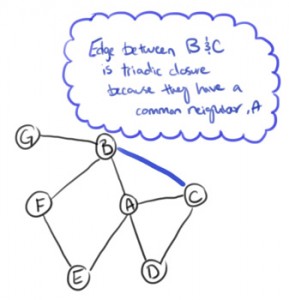
Source: https://blog.pokitdok.com/social-capital-within-social-health-networks/
I looked into how concepts related to graph theory that I learnt could better help us utilise the information on our users successfully. With miXXerS we can look not only at the network as a whole but the clusters and how the individuals in those clusters are influenced by their particular neighbours. With music this is especially true for listeners and can be amplified through the social network site. Our interactions with each other occur locally rather than globally as many times we care more about the decisions made by friends, family or colleagues.
This is important when exploring the link with the Triadic closure concept. This says that if two people in a social network have a friend in common, then there is an increased likelihood that they will become friends themselves at some point in the future. Spotify uses clusters to suggest new songs for its users by taking into consideration the types of genres you list to, which becomes particularly useful when looking for example for suggestions for those that listen to pop music which is very diverse. Using a system that adopts the triadic closure concept music and playlists are recommended.
“If you listen to one artist a lot, they will recommend another song by that artist, or music that has the same feel as that artist. If you only listen to one song by one artist, chances are you just like that song, not so much the artist, so Spotify will recommend a song with a similar feel to that song.” (Cornell University Blog)
Likewise, with respect to users of miXXerS if 2 people in the network have a common musician, DJ or concert they like, there is an increased likelihood that they will also become connected in the future for example through an event that they can be connected at in the case of miXXerS. As a result more targeted suggestions can be made.
In measuring betweenness centrality we will look at the important role of brokers in the network and seek to engage those users. Even if they have fewer direct connections they may be a single point of failure. Closeness Centrality is also important for even if a person have fewer connections the pattern of their direct and indirect ties can allow them to access all the nodes in the network more quickly than anyone else. They have the shortest paths to all others — they are close to everyone else. They are in an excellent position to monitor the information flow in the network — they have the best visibility into what is happening in the network.
Not all network paths are created equally however and more and more research shows that the shorter paths in the network are more important and so the key paths in the miXXerS networks may not be 6 degrees as often sited but 1 and 2 steps through direct and indirect connections. Therefore, it is important to know: who is in the clusters or network neighborhoods and then try to reach them through the influential individuals that lie therein. Some of this type of valuable information will also be available to those that pay for premium subscription.


